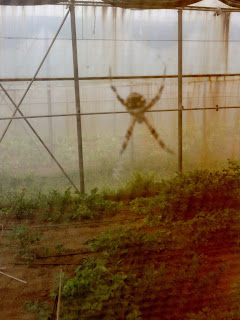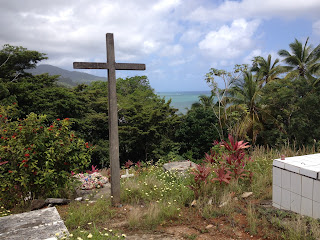There are a number of almond trees around my village, including directly in front of the school (see the picture below, where I'm talking to some students under the shade of the almond tree, with our school in the background) as well as a larger one by the bay. Once the almonds started appearing on our tree, students at lunch or break would pick (or knock down) the green almonds. The ones that managed to evade the students later turn reddish before falling off and turning brown as the leathery outer coating dried out.
Whether they were green, red, or brown, the larger nut must be cracked and removed (generally by pounding with a stone) to get to the little almond on the inside. The photo directly below shows the result after a youngster was bashing the brown, dried almond with a big rock. If you look close near his fingertips, you can see a small white circle—the “meat” of the actual almond—which had inadvertently been broken during this attempt to remove the hull. The second photo below shows an example where the almond split lengthwise. In the photo below, you can compare the size of the actual almond (which survived the rock-bashing process without breaking) with an adjacent larger version still retaining its hull. The taste is similar to what I remember getting in stores at home, but it is a lot more labor intensive to enjoy an almond off the tree.
Recently, I was invited to get a see a cashew tree growing in our village. Cashews and almonds are both technically seeds rather than nuts. The almond seed is encased in its hard, leather-like hull, but the cashew has a separate fruit—called the cashew apple—directly above the seed hull as shown below.
The fruit is very juicy, with a nice taste (although mine had a bit of a fibrous, stringy texture). The picture below shows a small one as I was halfway through eating it. The skin is somewhat fragile, which makes them difficult to transport—unlike the hard seeds that most Americans think of when they hear the word “cashew.” I was told that after eating the fruit, the kidney-shaped seed needed to be sun-dried, and then roasted to remove the outer hull and get to the real cashew. I thought it might be similar to roasting the cacao seeds when we were making cocoa tea, and that I might try it on my gas stove. However, after reading the following passage from Wikipedia, I have decided not to experiment with my leftover seeds.“The seed is surrounded by a double shell containing an allergenic phenolic resin, anacardic acid, a potent skin irritant chemically related to the better-known allergenic oil urushiol which is also a toxin found in the related poison ivy. Properly roasting cashews destroys the toxin, but it must be done outdoors as the smoke (not unlike that from burning poison ivy) contains urushiol droplets which can cause severe, sometimes life-threatening, reactions by irritating the lungs.”I'd rather not voluntarily deal with any toxins if I don't really need to do so. Not having poison ivy on this island was as welcome to me as not having venomous snakes, because I've suffered with itching from poison ivy on various occasions. Plus I remember warnings about phenol from my college summers working at BorgWarner Chemicals. Thus, I will stick to eating almonds occasionally and just the fruit of the cashew tree, but I'm not going to deal with the cashews themselves.
Those are the only the only nuts I am aware of in my area—unless you count coconuts, which (just like almonds and cashews) are not really true nuts (such as acorns) according to scientific definitions. However, I have learned so much down here about coconuts that they are a topic worthy of a future blog story.
In the meantime, try not to go nuts! And don't worry about me going nuts down here, because I'm having a great time! The students even convinced me that I'm not too old to also climb up the almond tree.

















































